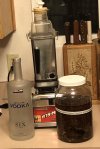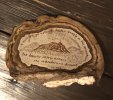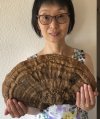Having been extremely intrigued by
 Howard Wallace
Howard Wallace
's post and supporting link of SHAMANIC FUNGAL MASKS -
http://forestpathology.cfans.umn.edu/pdf/Fungi_Magazine_Polypore_Masks_2017.pdf and then seeing these example photos (
3 below) I looked more into this subject of
TREE CONKS as shamanic objects.
I really don't know what compels me to these but I must admit that I have been collecting (
and discarding) tree conks since I was a kid. My Mom threw out quite a few over the years because I would bring them in bark and BUGS and all

Now though, I have my own house and lots of knives and love meandering in the woods always looking for a few rare collectibles. You can see some of the best ones in my earlier posts above. My wife seems to like having them around too.
BUT - this thing with the masks was all new to me. My first thought was that I have yet to find a polypore in my part of Maine big enough to make a mask for my big head. Yes, I could make some small ones as examples without ever wearing them for my "rituals"

but I decided to hunt for a relative Maine
Monster Conk and try to make a mask. Learning from the examples above that I could add pieces as needed freed up my thinking about how to proceed. Noses, in particular, were added on these ancient examples. Early this spring I found an old grayed out conk that was 13" wide x 9" + tall and by my local standards - a real BIG one. Normally these colorless ones are passed up but in this case the old gray seemed more perfect for my intent.
I also found a "chin" and a "nose" on other walk abouts over the past few months and so this past rainy weekend, in the spirit of the ancients but with no idea how to proceed, I commenced
my first Fungal Mask.
Here was my set up.
You can see my "monster" conk and a couple more diminutive ones along with my
mushroom knife and a puukko.
I soon realized that these little knives, sharp as they are were going to make nary a scratch in the leathery old conk.
MORE AND BIGGER KNIVES -
including an HI
OMG - the conk just laughed.

I had very intention of trying to make the mask somewhat authentically but then was soon compelled to philosophize that contemporary Shamans would use whatever useful tool they now had available to them and so I switched out my tools a bit.
YUP - I got out my SILKY Saw. One slice in and I realized - now what?

Big deal. Now I had a slice and needed to start carving IN to the conk to hollow out the back and still the knives were barely more than scrapers. The core was - as you can see - layered with growth rings, and the texture was akin to cutting through very dense cork. It was resilient, sometime stringy and nearly impossible to simply slice into.
BIG GUN TOOL OPTION
Well, with the multitool and
3 new sharp woodcutting blades - I was able to start hollowing. The puukko proved to be a very useful tool after all. The only knife of the group (some not included in the photo) that I could use, as it is slender and flexible and sharp, so I could actually slice and pare a bit as I worked.
And so I was on my way. I just snuck up on it. Worked a bit of carving - tried it to my face and then worked some more until I had a reasonably good contour without getting too close to the deep furloughs of the front sections.
NEXT POST -
RESULTS
to be continued...






